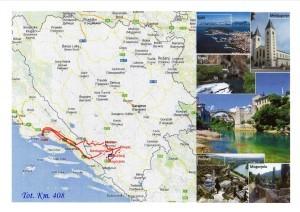
Della Bosnia, della sua accoglienza e ospitalità avevo sentito parlare alcuni cacciatori, miei amici che vanno spesso in quella terra a fare battute di caccia. Credevo esagerassero nei loro racconti, e devo ammettere che sono partita curiosa di vedere che fosse proprio così: ora sono io che devo ammettere che avevano ragione e adesso sono io a dire che l’accoglienza e l’ ospitalità di Bosnia mi mancano per la loro unicità…
Siamo partiti la sera da Ancona con il traghetto e dopo la traversata durata tutta la notte siamo sbarcati a Spalato alle 7 di mattina. E’ vero che avevamo le cabine, ma non sono riuscita a dormire tutta la notte, perché c’è sempre un qualcuno che va al di sopra delle righe e arreca notevole disturbo agli altri, comunque la cosa positiva, in mezzo a questa nota dolente, è che all’alba ero sul ponte e così ho potuto godere dello spettacolo meraviglioso del sole che sorge da dietro i monti delle isole della Croazia ed è stato così un ottimo inizio di giornata

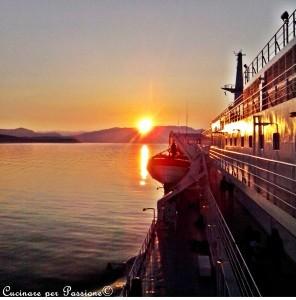
A Spalato c’era ad attenderci c’erano il pullman, con Adi, la nostra guida dalle mani grandi e io dico anche dal cuore grande , e il Sig. Bašić dell’Ente Turistico.
Benché fosse mattina presto l’afa e il caldo fossero già opprimenti, hanno fatto di tutto per rendere il nostro viaggio, che durava 3 ore, più confortevole.
Oltre che ad invitarci ad esprimere ogni nostra esigenza di sosta hanno inserito un piacevole fuori programma facendo tappa a Medjugorie.
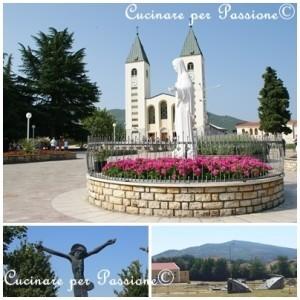
Forse le nostre domande sul luogo e la voglia di sapere dove si trova il Santuario li hanno indotti a fermarci li. Gli sono grata perché di fatto è stata la seconda dimostrazione della loro ospitalità e generosa accoglienza e a me oltre che a dissetarmi e rinfrescarmi questo luogo i ha dato anche un po’ di serenità…
Da qui siamo andati a Blagaj una cittadina situata alla sorgente di un fiume Buma famosa per il suo storico monastero derviscio.
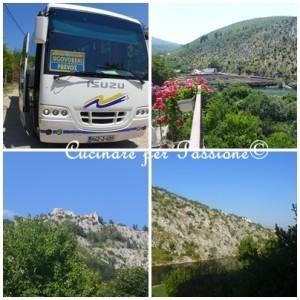
La prima tappa è stata a Casa Bašić, dove avremmo alloggiato per depositare i bagagli , poi abbiamo fatto visita all’area urbana storica della città, alla Velagic Casa un complesso residenziale della famiglia Velagic
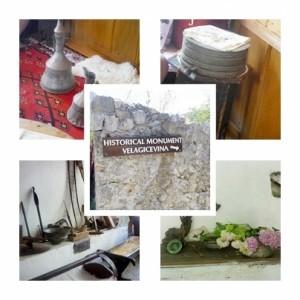
e al Tekke
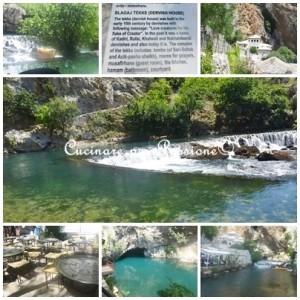
un complesso naturale e architettonico, di straordinaria bellezza, sulle sorgenti del fiume Buna.
E in questo spettacolare scenario abbiamo pranzato in un ristorante tipico posto proprio sulla riva del fiume.
Il pranzo era a base dei prodotti tipici della zona che ho molto apprezzato


Nel pomeriggio doccia ristoratrice e una merenda in riva al fiume nel giardino di a Casa Bašić con tanto di dolci casalinghi e limonata fresca e dissetante.
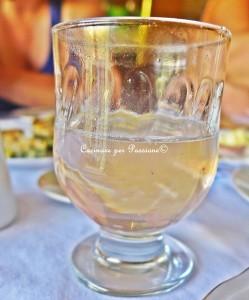
Erano anni che non bevevo più una limonata così… quando ho visto la brocca con l’acqua fresca e il limone appena spremuto mi si è aperto il cuore e sono tornata indietro negli anni, alla mia campagna nell’Oltrepo Pavese, alle estati a casa della nonna quando la sera seduti sull’aia ci si ritrovava tutti insieme: gli adulti a discorrere e noi bambini a giocare, e la limonata era la nostra unica bevanda… Era il segno dell’ospitalità e dell’accoglienza di casa mia, e l’averla ritrovata qua la dice lunga…
E proprio mentre eravamo in giardino ho provato un’altra grande emozione nel sentire la voce del muezzin diffusa dall’altoparlante del minareto che chiamava i fedeli alla preghiera.
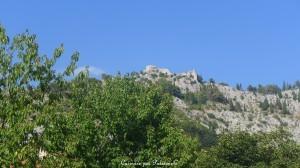
E’ una emozione che ho provato più volte in quei due gironi di Bosnia ed è una di quelle emozioni che rimarranno sempre in me.
Il nostro tour è proseguito poi nel pomeriggio a Počitelj una bellissima cittadina fortezza di epoca romana posta su di una collina, molto antica con le case di pietra e i vicoli tortuosi molto caratteristici.
Qui c’è , una fortezza medievale, l’antica Moschea Hajji Alija davanti alla quale c’è un bellissimo e vecchissimo albero e vi ha sede l’ International Artists Colony una attiva associazione di artisti del sud-est Europa.
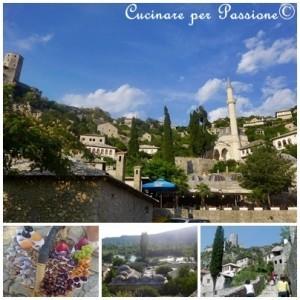
Successivamente abbiamo raggiunto Mogorjelo il più importante sito archeologico della Bosnia Erzegovina dove sono ci sono i resti di una antica villa romana, circondata da una fitta rigogliosa vegetazione mediterranea.
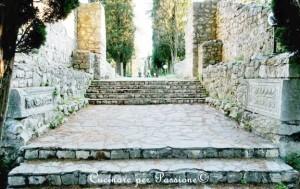
Dicono che non sia possibile separare la cultura e le tradizioni della Bosnia dalla sua natura incontaminata, dalla sua ricchezza geologica e archeologia formano un tutt’uno unico introvabile in altre parti…
E da qui via verso Mostar la città il cui simbolo è il Ponte a schiena d’asino sul fiume Narenta ai cui lati sorgono le due torri, l’ Helebija a nord est e la Tara a sud ovest che ne sono le mostari, ovvero le custodi.
E’ un ponte che tutt’oggi cerca di unire una città ancora divisa dal rancore etnico e dal denaro, ed è il simbolo del rilancio turistico e della rinascita dell’intero Paese.
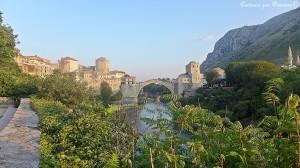
In Mostar abbiamo inoltre visitato il Kajtaz House (complesso residenziale),
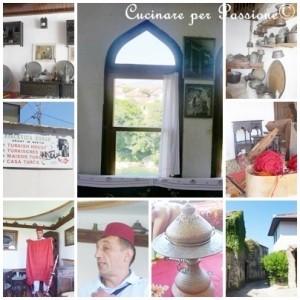
la Muslibegovic House (complesso residenziale della famiglia Muslibegovic, l’insieme architettonico),

il Biscevic House (complesso residenziale)
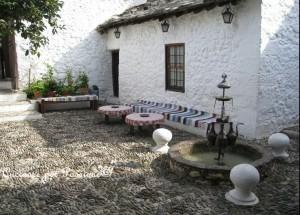
e la Moschea Koski MehmetPasa Kami

Abbiamo cenato e pranzato presso il Ristorante Labirint posto sulle rive del fiume Nerenta con una splendida veduta sul Ponte vecchio e anche qui abbiamo gustato piatti della tradizione molto buoni e gustosi.
Ma com’è la cucina bosniaca?
E’ una cucina abbastanza leggera e saporita ( usano molte spezie, ma in piccole dosi ) con un ampia varietà di piatti a base di carne ( manzo, agnello, selvaggina ) di pesce ( in particolare le trote che vengono allevate nei fiumi ) e di verdure e che include i sapori della cucina orientale e occidentale.
Vi parlo di alcuni dei piatti che ho conosciuto, spero solo di non avere fatto confusione nel prendere gli appunti mentre la bocca andava a mille e le papille gustative erano impegnate :-)
Sicuramente mi mancherà qualche foto: l’impegno a tavola era notevole, spero di poter recuperare magari in un’altra occasione…
Il piatto più tipico è la pita, un involucro di pasta sfoglia molto sottile farcito con vari ripieni ripieno a base di verdure, carni, formaggi e a seconda della farcia assume il nome di : burek (farcia di carne) sirnica ( farcia di formaggio ) zeljanica (farcia alle erbe )

Un altro piatto molto diffuso e che ho molto apprezzato sono le zuppe (corbe) tra cui la begova corba, una zuppa di pollo con verdure e riso.
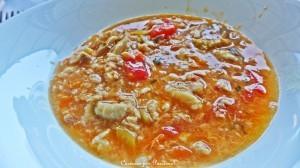
Anche le Dolma, ovvero verdure ripiene di riso e carne macinata sono un piatto molto conosciuto. La più diffusa è la Dolma di peperoni, quella di melanzane è detta Patlidzan dolma e quella di zucchine Tikvice dolma.
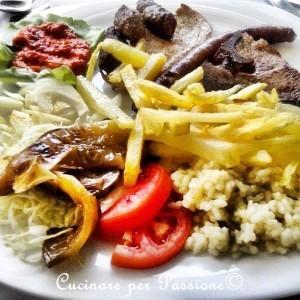
I piatti a base di carne più conosciuti e che ho gustato sono:
i ražnjići ovvero degli spiedini di carne di agnello,
i čevapčići, delle polpettine di ovino, e montone tritata, passati alla griglia e serviti con cipolla cruda,
i sarma involtini di carne di bovino tritata, avvolta in foglie di cavolo, fritta in padella e dorata al forno.
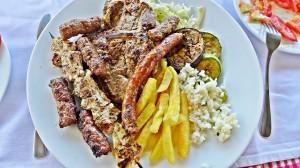
I formaggi, in bosniaco Sir generalmente sono freschi e acidi:
la Pávlaka è una panna acida molto densa, spalmabile ed è usata dappertutto nella cucina bosniaca.
Il Kájmak è un formaggio cremoso e molto grasso (60%) preparato utilizzando la panna, ha il sapore leggermente acido e salato.
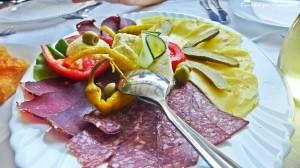
I dolci (kolači) sono quelli tipici orientali ( una libidine ) :
la baklava una sfoglia di pasta fillo tagliata a rombi, ripiena di noci tritate e ricoperta di sciroppo di zucchero.
gli hurmášica morbidi biscotti ricoperti di sciroppo di zucchero.
le frittelle (palačinke) e i pasticcini di pasta lievitata aromatizzati al limone o alla vaniglia.
i rúžica Pasta fillo arrotolata e tagliata a cilindretti ripiena di noci tritate e ricoperta di sciroppo di zucchero.
i tulumbe Biscotti fritti sommersi con sciroppo di zucchero.
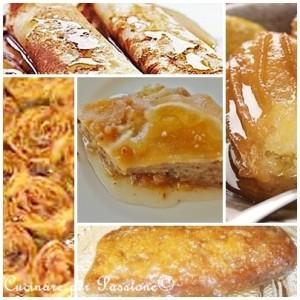
E poi c’è lui il caffè che viene in genere è servito alla turca, ovvero è finemente macinato e messo in fusione, si beve decantato e molto lentamente intingendogli zuccherini o dolcetti così come mi ha fatto vedere Adi.

Quello che mi fa sorridere, però è il fatto che il più delle volte nei locali i turisti bevono il caffè alla turca e la gente del posto il caffè espresso… Mah valli a capire!!!

E se volete saperne di più, ci vediamo presto!!!
Laura
*********
English version…
#Adriatictour: Bosnia: land of magical places where the welcome and hospitality are part of everyday life…
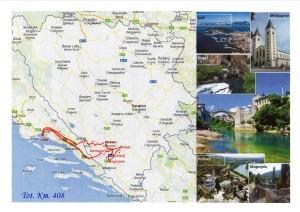
About Bosnia, I had heard about Bosnia’s way of welcoming visitors and about their hospitality from some friends, hunters who go there quite often on hunting trips. I thought they were exaggerating in their stories and I admit I went there curious to see if it was as they said: now I have to admit that they were right and now I am the one saying that I miss the welcoming and the hospitality of Bosnia for their uniqueness…
We departed from Ancona in the evening with the ferry and after the crossing that lasted all night we arrived in Spalato at 7 o’clock in the morning. We had cabins, but I didn’t sleep at all during the night because there is always someone who goes above the lines and causes significant disturbance to others, however the positive thing in the midst of this annoying situation, is that at dawn I was on the bridge and I was able to enjoy the wonderful sight of the sun rising from behind the mountains of the islands of Croatia and it was a such a great start to the day.

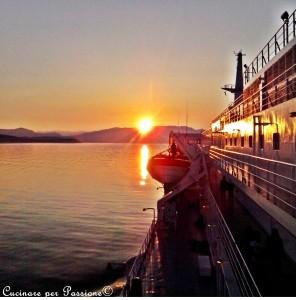
In Spalato a coach was waiting for us with Adi, our guide with big hands and a big heart (a personal consideration) and Mr. Bašić from the tourist board.
Although it was early morning the mugginess and the heat were already overpowering, they did everything they could to make our trip, which took three hours, as comfortable as possible. As well as asking us to tell them anytime we needed to stop they also organized a really nice surprise stop in Medjugorje.
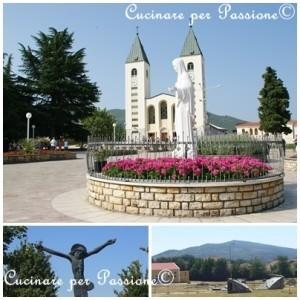
Maybe our questions about the place and our questions about where the Shrine was gave them the idea to take us there. I am grateful to them because in fact this was the second demonstration of their hospitality and their generosity; for me besides quenching my thirst and refreshing me it also gave my a sense of serenity…
From here we went to Blagaj, a small town situated at the spring of the river Buna, famous for its historical dervish monastery.
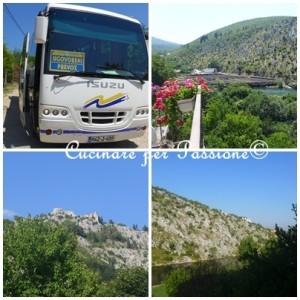
The first stop was at Casa Bašić, where we would stay and to drop off our luggage, then we went to visit the historical urban area of the town, to Velagic House a residential complex of the Velagic family

and to Tekke
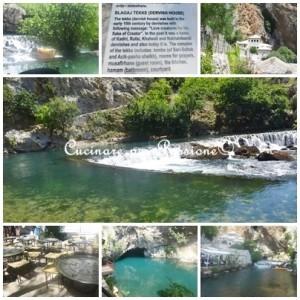
a natural and architectonic complex of extraordinary beauty at the springs of the river Buna.
In the midst of this beautiful scenery we had lunch at a traditional restaurant on the bank of the river.
Lunch was made with traditional products of the area that I enjoyed.

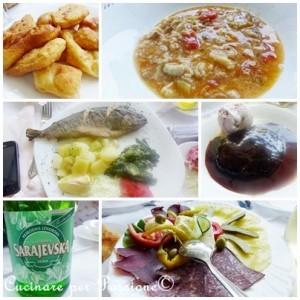
In the afternoon after a refreshing shower, a snack in the garden of Bašić House on the river bank, with lots of homemade cakes and fresh thirst-quenching lemon juice.
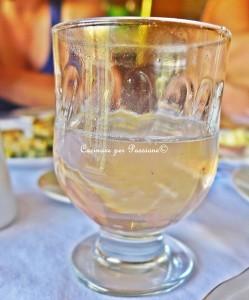
It had been years since I drank lemon juice like that… when I saw the jug of fresh water with freshly squeezed lemons my heart opened with emotion and my mind went back to when, during summer in the countryside of Oltrepo Pavese where I spent my summers at my grandmother’s house; in the evening we would all gather together in the courtyard, adults talking about their day while the children were playing and our only drink was fresh lemon juice… It was a sign of hospitality and welcoming at my home and finding it here was so nice…
While we were in the garden I experienced another type of emotion when I heard the voice of the muezzin over the loudspeaker of the minaret calling the devoted to prayer.
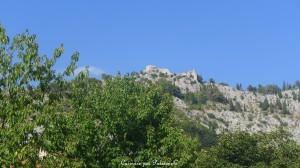
It is an emotion I experienced several times during our two days in Bosnia and it will remain with me always.
Our tour continued in the afternoon to Počitelj, a beautiful fortified town from Roman times that is situated on a hill. It is an ancient town with stone houses and characteristic winding alleys.
There is a Medieval Fortress, the ancient Mosque Hajji Alija in front of which there is a beautiful very old tree and here is the headquarters of the International Artists Colony an association of artists from South-East Europe.
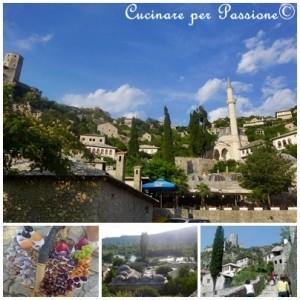
Later we arrived at Mogorjelo, the most important archaeological site of Bosnia Erzegina where the remains of an ancient roman villa are surrounded by thick and dense Mediterranean vegetation.
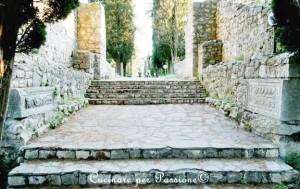
They say that it is impossible to separate the culture and the traditions of Bosnia from its uncontaminated nature and from its geological and archaeological wealth which together form a unique “whole” hard to find anywhere else…
From here we went towards Mostar, the city whose symbol is the Bridge (formed like a donkey’s back) over the river Narenta at which sides raise the two towers, to the northeast the Helebija and to the southeast the Tara that are the mostari, or rather the custodians.
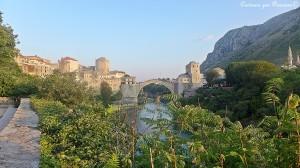
It is the bridge which even today tries to unite a city still divided by ethnic resentment and by money and it is the symbol of the relaunching of tourism and the rebirth of the whole country.
In Mostar we also visited the (residential complex) Kajtaz,
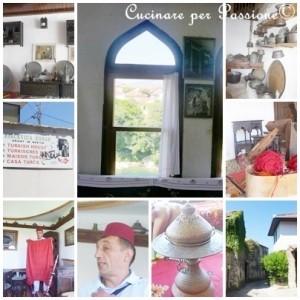
the Muslibegovic House (residential complex from the Muslibegovic family and architectural ensemble),

the (residential complex) Biscevic House
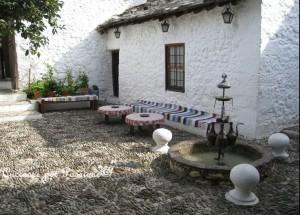
and the Koski Mehmed Pasa Mosque.
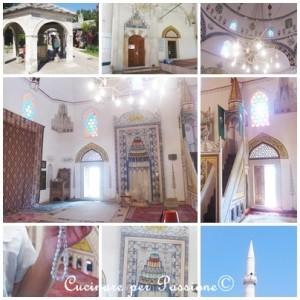
We ate dinner and lunch at the Labirint Restaurant on the bank of the river Nerenta with a beautiful view of the old bridge, and here again we enjoyed very good and tasty traditional dishes.
What is Bosnian cuisine like?
It is quite light but tasty (they use a lot of spices, but in small amounts) they have a large variety of dishes with meat (beef, lamb, game) with fish (in particular trout raised in the rivers) and vegetables with flavours from western and oriental cuisine.
I will tell you about some dishes I tasted, I just hope I didn’t confuse them when taking notes while my mouth was enjoying the food and my taste buds were working overtime…
I will definitely be missing some photos: which I hope to recuperate some on another occasion.

The most typical dish is pita, a thin roll of puff pastry stuffed with different types filling: vegetables, meat, cheeses and depending of the filling they are named: burek (meat filling) sirnica (cheese filling) zeljanica (herb filling).
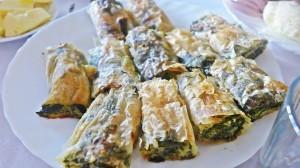
Another very popular dish which I enjoyed are their soups (corbe) among which is the begova corba, a chicken soup with vegetables and rice.
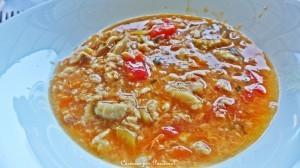
Also the Dolma, or rather vegetables stuffed with rice and minced meat are a well-known dish. The most popular is the Dolma with peppers, the one with aubergines is called Patlidzan dolma and the one with corgettes is Tikvice dolma.
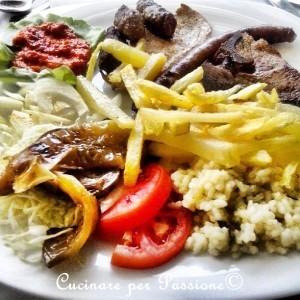
The most popular meat dishes that I tasted are:
ražnjići or rather spiedini with lamb,
čevapčići, meat balls with minced beef and mutton, grilled and served with raw onion,
sarma roles of minced beef wrapped in cabbage leaves, fried in the pan and browned in the oven,
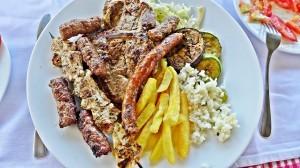
cheeses in bosnian Sir are generally fresh and sour:
Pávlaka is a very thick spreadable sour cream that is widely used in Bosnian cuisine.
Kájmak is a very creamy cheese (60%) fat prepared using cream, it has a slightly acid and salty taste.
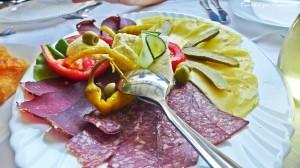
The desserts (kolaci) are typically oriental and delicious:
Baklava a layer of filo pastry cut into diamond shapes, filled with crushed nuts and covered with a sugar syrup.
Hurmasica soft biscuits covered with a sugar syrup.
Fritters (palacinke) little yeast pastries flavoured with lemon or vanilla.
Ruzica filo pastry rolled and cut into tubes filled with crushed nuts and covered with sugar syrup.
Tulumbe fried biscuits dipped in sugar syrup.
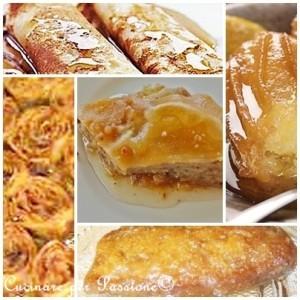
And then there is coffee that is normally served Turkish style, or rather, finely grated and made by the fusion method. It is drunk slowly dipping sugar lumps or little biscuits as Adi demonstrated.
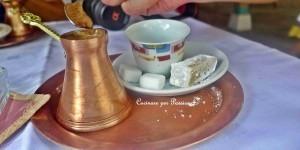
What made me laugh though, is that most tourists drink their coffee Turkish style, but the locals drink espresso coffee! I dont’ understand

If you want to know more … see you soon
Laura
transletion by Christine Burgess






COMMENTI (1)